Embark on a captivating journey through Massachusetts’ diverse birding landscape with our comprehensive guide. This Ultimate Guide highlights the 34 most common birds found throughout the Bay State, offering detailed insights into their habitats, behaviors, and distinctive characteristics.
Whether you’re a dedicated birder, an outdoor enthusiast, or simply curious about Massachusetts’ unique birdlife, this guide provides a fascinating exploration of the avian wonders that grace this historic state.
Table of Contents
- 1 Backyard Birds in Massachusetts
- 1.1 Black-capped Chickadee
- 1.2 Blue Jay
- 1.3 American Robin
- 1.4 Northern Cardinal
- 1.5 Song Sparrow
- 1.6 American Crow
- 1.7 Mourning Dove
- 1.8 American Goldfinch
- 1.9 Tufted Titmouse
- 1.10 Downy Woodpecker
- 1.11 White-breasted Nuthatch
- 1.12 Red-winged Blackbird
- 1.13 House Sparrow
- 1.14 Common Grackle
- 1.15 Gray Catbird
- 1.16 European Starling
- 1.17 Red-bellied Woodpecker
- 1.18 Northern Flicker
- 1.19 House Finch
- 1.20 Dark-eyed Junco
- 1.21 Tree Swallow
- 2 Frequently Asked Questions
- 3 Author
Backyard Birds in Massachusetts
Black-capped Chickadee

The Black-capped Chickadee is a small songbird with an extensive range that includes all of North America, parts of Central America and northern South America. They inhabit both deciduous and coniferous forests from southern Canada to central Mexico. These birds are very adaptable to different habitats, but prefer mixed or deciduous woodlands where they can feed on the ground as well as in trees.
Their diet consists mainly of insects such as ants, beetles, grasshoppers, but sometimes includes plant matter such as buds or berries. The best place to look for Black-capped Chickadee is on the northern tip of Cape Cod. You can find them around the coastline in May and June. In July, they fly up the eastern coast into Maine and Canada, and in August they will fly southward across the Atlantic Ocean.
- Frequency: 48.15%
- Color: Black cap, white on face, white/reddish-brown flanks
- Habitat: Deciduous and mixed forests, backyards, parks
- Range: USA and Canada
- Size: 11.5 -16 cm
- Weight: 8 – 15 grams
- Diet: Insects, seeds, berries
- Family: Paridae
- Genus: Poecile
Related Post:
- How Do I Attract Chickadees To My Yard?
- Unique Black-capped Chickadee Facts
- 13 Birds That Look Like Chickadees
Blue Jay
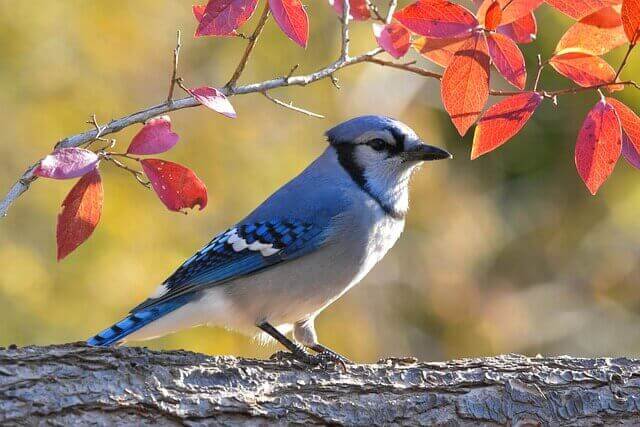
Blue Jays are one of the most recognizable birds in North America. They live throughout Canada and the United States, with a small population residing in Mexico. They feed on insects, grubs, worms and berries. Blue Jays also scavenge for food when they can’t find it themselves, such as uneaten seeds from animals or plants that have fallen to the ground.
There are a couple of places where you can see this beautiful songbird and some of these spots are in Dorchester, which is in the state of Massachusetts, and around the Cape Cod area of Massachusetts.
- Frequency: 46.56%
- Color: Blue crest on head, wings, back, and tail, and has a white face and belly
- Habitat: Deciduous and mixed forests, mixed woodlands, backyards, parks
- Range: Southern Canada, Eastern and Central United States, Florida and Texas
- Size: 8 – 12″ inches
- Weight: 70 – 100 grams
- Diet: Nuts, seeds, caterpillars, grasshoppers, and beetles
- Family: Corvidae
- Genus: Cyanocitta
Related Posts:
- What Attracts Blue Jays to your Yard
- Do Blue Jays Migrate? The Truth
- What do Blue Jay Eat – All The Facts
- 15 Best Bird Feeders for Blue Jays
American Robin

The American Robin is a type of bird that lives in North America. The most popular place to find them is in the eastern part of the United States, but they are also found on Canada’s west coast, and Mexico’s Pacific Coast. Robins will typically live in open fields or meadows with trees nearby, but will also sometimes find homes near water sources such as ponds or rivers.
These birds are omnivores, meaning they eat both plants and animals, including worms, caterpillars, spiders, berries, eggs, and fruit. American Robins are easily visible in the late afternoon or early morning.
- Frequency: 45.76%
- Color: Mostly brown on the back with an orange colored breast
- Habitat: Wooded areas, backyards, parks, fields
- Range: USA, Canada, Mexico
- Size: 12 – 16″ inches
- Weight: 72 – 95 grams
- Bill: Yellow bill, stout and straight with a sharp point.
- Diet: Fruits, berries and insects (earthworms, beetles, caterpillars.
- Family: Turdidae
- Genus: Turdus
Related Post:
Northern Cardinal
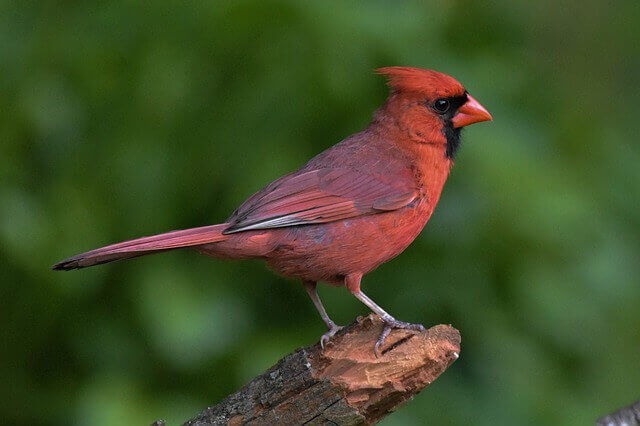
The Northern Cardinal is a bird with an extremely wide range and many habitats. They are found in most of the eastern half of North America, from the East Coast to the Rocky Mountains, including all but parts of Maine, New Hampshire, Vermont and Minnesota. Cardinals are typically found in open areas such as pastures, parks and yards, but they will also inhabit more wooded areas where there are large trees or shrubs.
They have a diet that consists mainly of seeds and insects such as beetles, caterpillars and grubs. Their migration pattern follows changes in temperature throughout the year; they move south for winter while moving north for summer.
- Frequency: 43.02%
- Color: Mostly red with black mask on the face
- Habitat: woodlands, gardens, parks, backyards and wetlands
- Range: USA, Canada, Mexico
- Size: 8.2 – 9.3″ inches
- Weight: 33 – 65 grams
- Diet: Fruits, berries and insects (grasshoppers, beetles, snails, cicadas)
- Family: Cardinalidae
- Genus: Cardinalis
Related Posts:
- Where are Cardinal Birds Found – Best Places to Look
- Cardinal Bird Facts You Never Knew
- 10 Best Bird Feeders for Cardinals
Song Sparrow
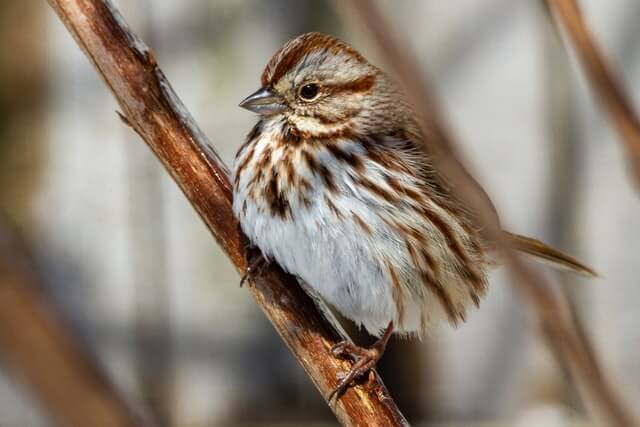
The Song Sparrow is a small bird that has a variety of habitats. The song sparrow ranges from the eastern coast to the west coast, as well as inland in the central and southern United States. This species lives mostly in urban areas such as yards, parks, farms and other types of habitats near human development. Their diet consists mainly of insects like grasshoppers, beetles and caterpillars, which they catch on the ground or while perched. They also eat seeds from plants or flowers.
The migration pattern for this species varies depending on where they live, but can be anywhere from Canada to southern Mexico or Central America.
- Frequency: 42.72%
- Color: Gray head, white cheek, a black bib, rufous neck
- Habitat: Urban centers, farms, backyards, edges, yards, and parks
- Range: Europe, Mediterranean, Asia, Australasia, Africa, and the Americas
- Size: 5.5 – 7.0″ inches
- Weight: 25 – 40 grams
- Diet: Grains, seeds and insects
- Family: Passeridea
- Genus: Passer
Related Post: How to Attract Sparrows to your Backyard
American Crow
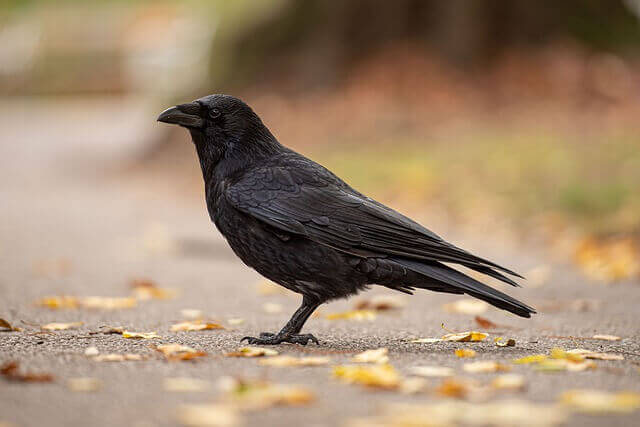
The American Crow is a large black bird that has adapted to live in urban areas and even the tundra. They are found throughout North America, from Alaska down to Florida. The American Crow lives mainly in forested areas but can also be found in farmland, grasslands, shrubland and wetlands. Their diet consists of invertebrates such as insects and earthworms as well as fruits, berries and nuts when available.
Crows are not migratory birds, so they can be seen year-round all over North America except for some places during winter where there is heavy snow cover or a lack of food sources.
- Frequency: 39.37%
- Color: Black
- Habitat: Open country, farms, parks, woodlands, towns, cities
- Range: Canada, USA, Mexico
- Size: 16 – 21″ inches
- Weight: 315 -620 grams
- Diet: invertebrates, carrion, seeds, eggs fish, grains, mice, frogs, and other small animals.
- Family: Corvidae
- Genus: Corvis
Related Posts:
Mourning Dove
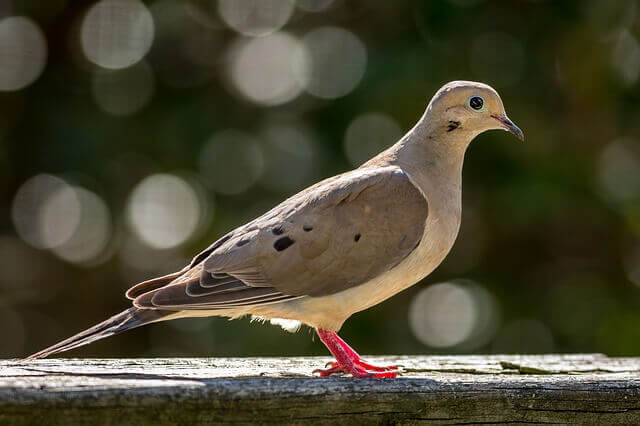
Mourning doves are found in North America and is one of the most abundant birds on earth. These animals range from southern Canada to central Mexico, with their habitat being forest edges, meadows, parks and fields.
They migrate as far south as Guatemala during winter months to escape cold weather, but can be seen all year round throughout its habitat in the United States. Their diet consists mainly of grains and seeds that they find on the ground or tree bark; they also eat insects for protein.
- Frequency: 39.00%
- Color: Light gray-brown and lighter and pinkish below. The wings have black spots.
- Habitat: Open habitats, urban areas, farms, prairie, grassland, wooded area
- Range: USA, Canada, Mexico, Central America, Greater Antilles
- Size: 12″ inches
- Weight: 112 – 170 grams
- Diet: Rapeseed, corn, millet, safflower, sunflower seeds, pokeberry, sesame, and wheat.
- Family: Columbidae
- Genus: Zenaida
Related Posts: 10 Facts about Mourning Doves
American Goldfinch
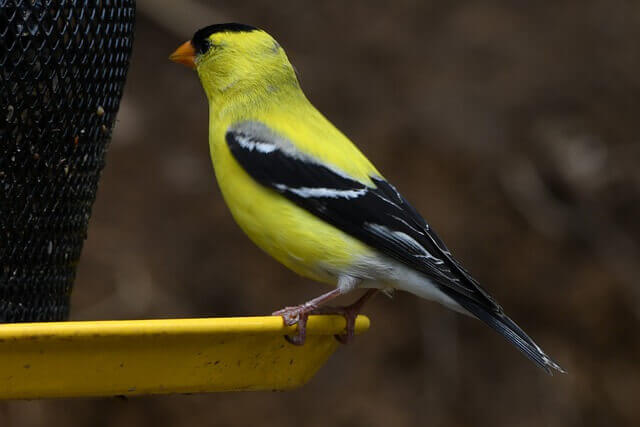
The American Goldfinch is a bird that is native to the Eastern part of the United States and Canada. They are found primarily in deciduous woodlands, orchards, parks and gardens. They primarily eat insects like ants and beetles for protein, and seeds such as sunflower seeds, thistle seed, niger seed, acorns and juniper berries, and fruit.
Goldfinches live in temperate climates across North America, with some of them migrating to Mexico for the winter months, while others migrate to Canada or other parts of the United States.
- Frequency: 38.50%
- Color: Face, neck, and underside are yellow, black wings with white bars
- Habitat: Deciduous forests and thickets, roadside, grasslands, backyards, meadows
- Range: Canada, USA and Mexico
- Size: 4.3 – 5.5″ inches
- Weight: 12 -18 grams
- Diet: Grass, dandelions, chickweed, sunflowers and ragweed, thistle, red alder, birch, spruce seeds
- Family: Carduelinae
- Genus: Spinus
Related Post: American Goldfinch Interesting Facts
Tufted Titmouse

The Tufted Titmouse is a bird that has long been a symbol of faith. It is very common in Massachusetts and other parts of New England.
It is native to both Europe and Asia and is often seen on the ground or around trees. A tufted titmouse in Massachusetts is an amazing bird to see.
- Frequency: 34.26%
- Color: Gray upper, white front, tufted gray crest on the head
- Habitat: Deciduous forests,river basin, backyards, swamps
- Range: Canada, USA and Mexico
- Size: 5.5 – 6.4″ inches
- Weight: 18 – 26 grams
- Diet: Nuts, insects, berries, seeds small fruit, and snails
- Family: Paridae
- Genus: Baeolophus
Related Post: How to Attract Tufted Titmouse to my Yard
Downy Woodpecker
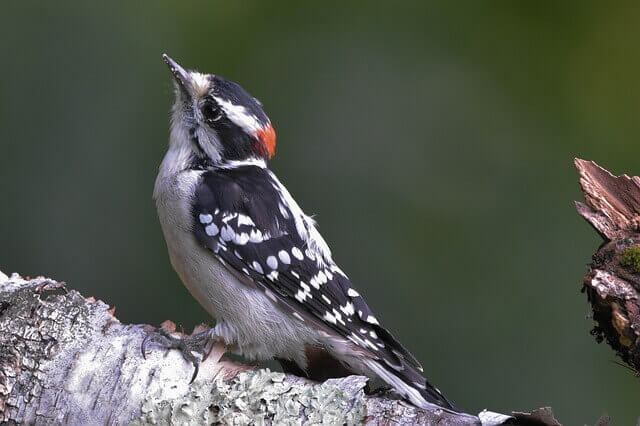
The Downy Woodpecker is a type of woodpecker that has a range from southern Canada to northern Mexico. These Woodpeckers live in deciduous forests, mixed forests, forest edges and open fields near woodlands where they find plenty of food and shelter from predators.
The Downy Woodpeckers diet consists mainly of insects and tree sap, but it will also eat nuts, berries, seeds and fruit. It nests on trees usually near the ground or at least 6 meters up. These birds migrate during the winter months, when their food sources become scarce.
- Frequency: 33.13%
- Color: Black with a white throat, belly, and back. White spots on wings
- Habitat: Deciduous forests and thickets, roadside, grasslands, backyards, parks
- Range: Canada, USA, and Mexico
- Size: 5.5 – 7.1″ inches
- Weight: 20 – 33 grams
- Diet: Mostly insects and beetles and ants, also gall wasps, caterpillars
- Family: Picadae
- Genus: Dryobates
Related Posts: How to Attract Downy Woodpeckers: Expert Tips!
White-breasted Nuthatch
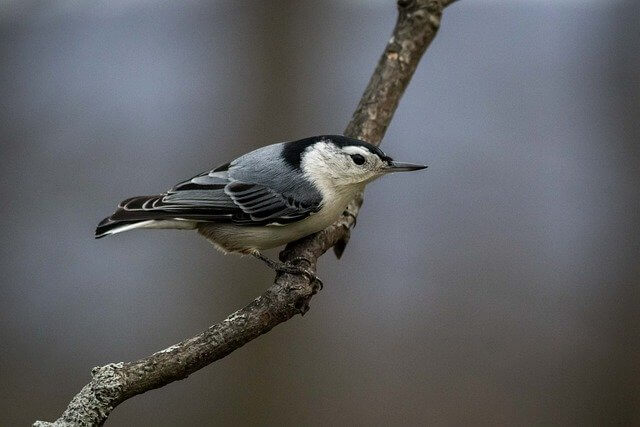
The White-breasted Nuthatch Range includes all of North America, except for the southeastern United States. This bird’s habitat ranges from deciduous forest to mixed forests to coniferous forests.
This species’ diet consists mainly of insects and seeds during summer months but changes in winter when they are reliant on nuts, acorns and pine seeds. These birds live year round north of Mexico but migrate south for winter, where they can be found as far south as Panama.
- Frequency: 28.87%
- Color: White face, flanks and chest. It has a black cap on it’s head a bluish gray upper and brown lower belly
- Habitat: Deciduous forests, conifers, roadside, rivers, backyards, parks
- Range: Southern Canada, USA
- Size: 5.9″ inches
- Weight: 20 grams
- Diet: Acorn nuts, hickory nuts, ants, caterpillars, scale insects, pine weevils
- Family: Sittidae
- Genus: Sitta
Related Post: How to Attract Nuthatches to your Backyard
Red-winged Blackbird

The Red-winged Blackbird is one of the most common and widespread birds in North America. They are also found throughout Mexico, Central America, parts of South America and the Caribbean. Red-winged blackbirds can be found in a variety of habitats including agricultural fields, marshes, swamps, forests and urban areas.
These birds are omnivores, with their diet consisting mainly of insects, but they will also eat seeds from grasses or plants as well as fruits when available. They live year round in northern areas, but migrate south to warmer climates during winter months, when there is a shortage of food.
- Frequency: 28.48%
- Color: All black with red patches on shoulder and a yellow wing bar
- Habitat: Deciduous forests, conifers, roadside, rivers, backyards, parks
- Range: North America, Central America
- Size: 6.7 – 7.1″ inches
- Weight: 41.5 – 65 grams
- Diet: Seeds and insects (butterflies, dragonflies, moths, frogs, worms,spider, smails, carrion, flies.)
- Family: Icteridae
- Genus: Agelaius
House Sparrow
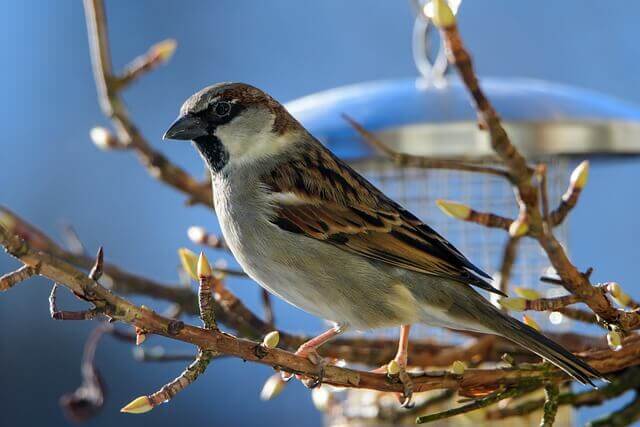
The House Sparrows are one of the most common bird species in North America. They can be found all over the continent, from Alaska to Mexico and many places in between. Their range includes most of North America. They inhabit any area with large buildings such as urban centers or farmland.
The diet of the House Sparrows consists mainly of seeds from grasses, weeds and grains. House sparrows are migratory birds that travel south for the winter to avoid cold weather, with some populations travelling as far as South Africa during this time.
- Frequency: 28.03%
- Color: Gray head marking, a reddish-brown back, and gray underparts
- Habitat: Urban centers, suburban areas, backyards, edges, yards, and parks
- Range: North America, Central America, South America, Africa, Australia, New Zealand
- Size: 5.5 – 7.1″ inches
- Weight: 25 – 39 grams
- Diet: Insects, beetles, caterpillars, aphids,, grasshoppers, crustaceans, earthworms, vertebrates
- Family: Passeridea
- Genus: Passer
Related Post: How to Attract Sparrows to your Backyard
Common Grackle
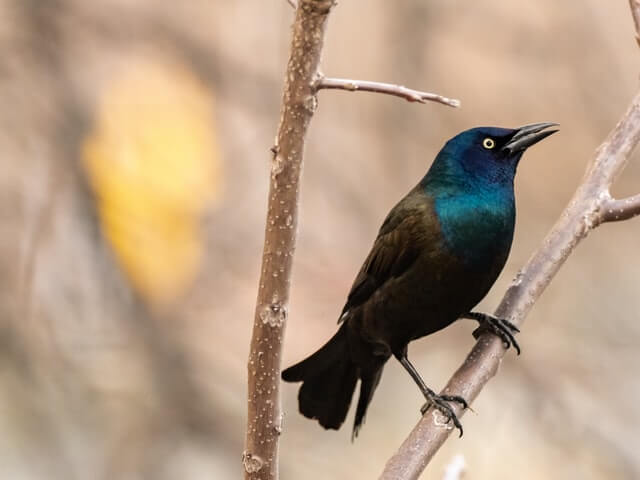
The Common Grackles are a species of bird that can be found in North America. They have a large range and are most commonly found throughout the United States. This is because they enjoy living near water, especially ponds or streams. There are many types of habitat for these birds to live in including: cities, rural areas, forested regions and wetlands.
Common Grackles eat mostly insects but will also consume worms, crickets and small rodents when they can find them, as well as fruits and grains. The common grackle migrates during spring and fall to avoid extremes in temperature or food shortages caused by lack of rain or heavy snowfall.
- Frequency: 27.58%
- Color: Black overall with a blue, and purple iridescence. Its body plumage is a shimmering copper color.
- Habitat: Woodlands, marshes, meadows, parks, backyards and fields
- Range: East of the Canadian Rockies,Canada and the United States
- Size: 11 – 13″ inches
- Weight: 75 – 143 grams
- Diet: minnows, eggs, berries, seeds, grain, insects, frogs, mice
- Family: Icteridae
- Genus: Quiscalus
Gray Catbird
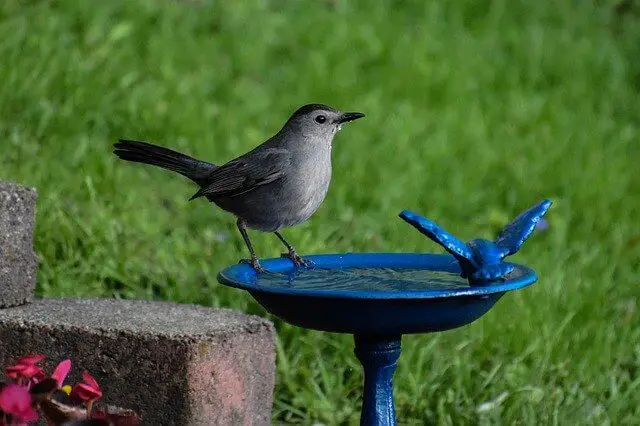
The Gray Catbirds are an interesting bird to observe in the Eastern North America. These birds have a limited range, found mainly in the United States and Canada. They live most of their lives near water sources such as ponds, marshes, streams or rivers where they feed on insects such as caterpillars, beetles, wasps and grasshoppers, but they also eat fruits, berries and seeds.
Gray Catbirds migrate south for the winter to escape the cold weather, but will sometimes stay north if there is not enough food that can be found there. In autumn, these birds migrate southwards for the winter months, which is when we see them return north during springtime. They are often found in fields and forests throughout Massachusetts.
- Frequency: 23.70%
- Color: Mainly Gray with black on tail and head, white accents on body
- Habitat: Woodlands, marshes, meadows
- Range: East of the Canadian Rockies, Canada, USA, Mexico, Central America, and the Caribbean
- Size: 8 – 9.5″ inches
- Weight: 23 – 57 grams
- Diet: Fruits, berries, earthworms, beetles, bugs, ants caterpillars, grasshoppers, moths.
- Family: Mimidae
- Genus: Dumatella
European Starling
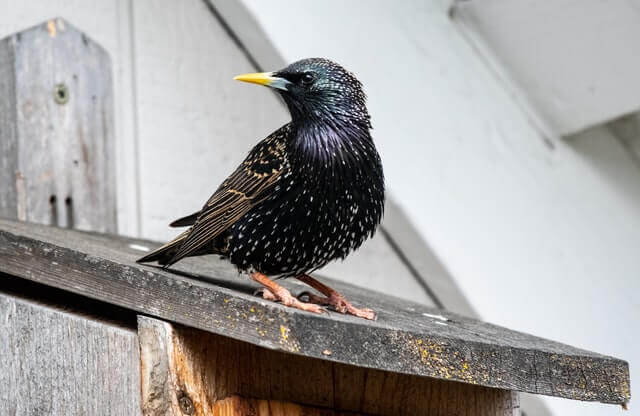
The Common Starlings range spans the entire Northern Hemisphere. Their habitat ranges from deserts to grasslands to wetlands, but they can also be found in urban areas where there are trees or other tall structures that provide roosting sites.
The starling’s diet consists mainly of invertebrates and earthworms, insects, fruits and berries that it forages on the ground or by gleanings from tree branches. Starlings are migratory birds which fly south in winter to warmer climates, where they feed on insects found near water sources.
- Frequency: 23.53%
- Color: Black with glossy iridescence plumage
- Habitat: Forests, woodlands, backyards, edges, yards, and parks
- Range: North America, Europe, Africa, India, Middle East, China
- Size: 7 – 9″ inches
- Weight: 60 – 100 grams
- Diet: Insects (ants, beetles, invertebrates), fruits, seeds, berries
- Family: Picadae
- Genus: Colaptes
Related Post: How to Attract European Starlings to your yard?
Red-bellied Woodpecker
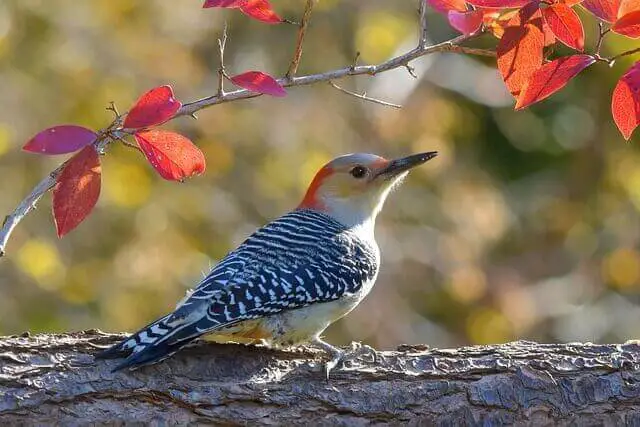
The Red-bellied Woodpecker is one of the most widely distributed woodpeckers in North America. They can be found from southern Canada to central Mexico, and east to West Virginia. These birds live in a variety of habitats, including deciduous forests, mixed forests with both hardwoods and conifers, oak savannas, pine woods or brushy clearings.
They are omnivores that eat insects such as ants, beetles and other small invertebrates; they can be seen using their bills to poke into holes for food, as well as berries and fruit when available. They will migrate for long distances during winter months when food becomes scarce or difficult to find due to cold weather.
- Frequency: 19.76%
- Color: Gray underside and face, red cap and a reddish belly, black/white pattern on wings
- Habitat: Forests, woodlands, backyards
- Range: Eastern USA and Canada
- Size: 9 – 10.5″ inches
- Weight: 56 – 90 grams
- Diet: Insects, fruits, seeds, eggs, frogs, sap, and fish
- Family: Picadae
- Genus: Melanerpes
Related Post: How to Attract Red-bellied Woodpeckers to your Yard?
Northern Flicker
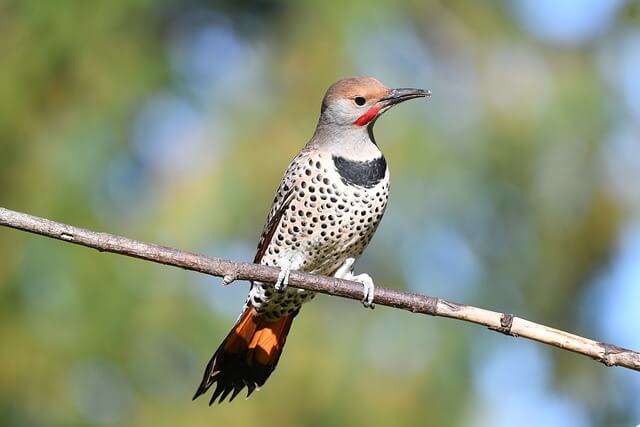
The Northern Flickers Range is found in the United States and Canada. They are very adaptable to different habitats from dense forests, farmland, deserts, grasslands and even urban areas.
The flicker’s diet consists of insects like beetles, ants, flies and caterpillars as well as fruits from trees or shrubs such as berries or cherries. They migrate south for winter, but will come back north when it starts getting warmer again.
- Frequency: 18.82%
- Color: Light brown with black bars across back, chest, wings, belly
- Habitat: Forests, woodlands, backyards, edges, yards, and parks
- Range: North America, Central America, Cuba, Cayman Islands
- Size: 10 – 14″ inches
- Weight: 85 – 165 grams
- Diet: Insects (ants, beetles, invertebrates), fruits, seeds, berries
- Family: Picadae
- Genus: Colaptes
Related Post: How to Attract Northern Flickers to your Backyard
House Finch

The House Finch is a species of bird that lives in North America. The House Finches range covers the southern half of Canada and extends south to central Mexico, most notably seen in the United States. They can be found as far north as Alaska, Newfoundland and Greenland.
House Finches prefer open woodlands or forest edges with brushy undergrowth that offer good sources of food such as seeds or insects on the ground below trees where they can find them easily while hopping about on the ground beneath the tree canopy. These birds migrate annually to the Southern United States during winter months.
- Frequency: 18.77%
- Color: Reddish face and upper breast, brown streaks on back, belly, and tail.
- Habitat: urban and suburban areas, backyards, edges, yards, and parks
- Range: Canada, USA, Mexico
- Size: 5 – 6″ inches
- Weight: 16 – 27 grams
- Diet: Aphids, grains, seeds, berries, nettle, dandelion, sunflower
- Family: Fringillidae
- Genus: Haemorhous
Related Post: How to Attract House Finch to your Yard
Dark-eyed Junco

The Dark-eyed Juncos are found in the North America and their range is throughout Canada, Greenland, Mexico, United States. They live in a variety of habitats including wet meadows, marshes, lakesides as well as farmland. Their diet consists mainly of seeds from grasses and weeds, which they eat during the winter months.
In addition to this, they will also feed on berries and insects. They typically migrate south for the winter months, and return north as early as March or April before staying for breeding season (late May through July).
- Frequency: 16.75%
- Color: Gray head, neck, breast, gray/brown backs and wings, white underside
- Habitat: Wooded areas, forest edges, roadsides, gardens, parks.
- Range: USA and Canada
- Size: 5.1 – 6.9″ inches
- Weight: 18 – 30 grams
- Diet: Seeds, insects, and arthropods
- Family: Passeriformes
- Genus: Junco
Related Post: Interesting Dark-eyed Junco Fun Facts
Tree Swallow
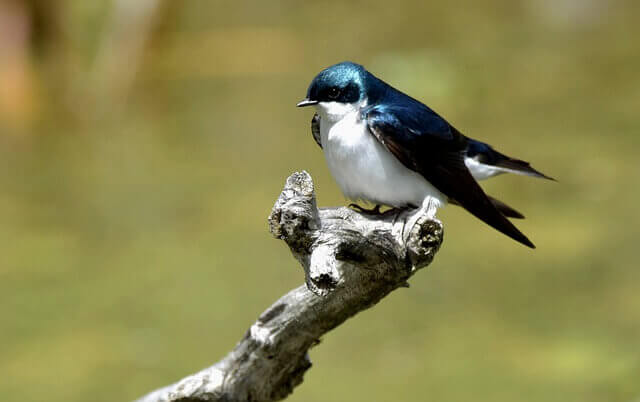
The Tree Swallows are migratory birds that live in North America. They migrate south for the winter and return north when spring arrives. Their range is from Alaska to Mexico, with some rare sightings in California.
Their habitat includes rivers, ponds, marshes and woodlands where they nest on branches of trees close to water sources or man-made habitats such as houses and bridges. They eat a variety of insects including flies, beetles, mosquitoes and dragonflies as well as berries, fruit and fish when necessary.
- Frequency: 16.01%
- Color: Bluish-green upper with black wings and tail, and white underbody
- Habitat: Open wooded areas
- Range: USA, Canada, South America
- Size: 4.5 – 5.5″ inches
- Weight: 17 – 26 grams
- Diet: insects, molluscs, spiders, and fruit
- Family: Hirundinidae
- Genus: Tachycineta
Related Post: How to Attract Swallows to my Yard
These backyard birds all have a frequency of less than 16%
- Chipping Sparrow (Frequency 15.27%)
- White-throated Sparrow (Frequency 15.06%)
- Carolina Wren (Frequency 14.43%)
- Eastern Phoebe (Frequency 13.45%)
- Common Yellowthroat (Frequency 12.76%)
- Northern Mockingbird (Frequency 12.34%)
- Cedar Waxwing (Frequency 11.10%)
- Baltimore Oriole (Frequency 11.08%)
- Brown-headed Cowbird (Frequency 10.04%)
- Hairy Woodpecker (Frequency 10.59%)
- Yellow-rumped Warbler (Frequency 10.47%)
- Yellow Warbler (Frequency 10.34%)
- Eastern Towhee (Frequency 10.25%)
Frequently Asked Questions
What is the official bird of Massachusetts?
The Black-capped Chickadee is the official bird of Massachusetts. In 1941, the black-capped chickadee was designated as the state bird. This choice was likely due to their reputation for being found in all habitats in New England and are most commonly seen wintering on evergreens such as spruce, pine, and fir trees.
What is the most common hawk in Massachusetts?
The red-tailed hawk is the most commonly seen hawk, with a 16% frequency of occurrence. This hawk can be found in nearly every part of Massachusetts, and it’s not uncommon to see them flying over towns or perching on utility poles during their migrations. They are also one of the more commonly seen hawks because they tend to stay close to where people live and visit.
Do cardinals live in Massachusetts?
The red bird is native to the Eastern United States, and there are many areas of Massachusetts where they can be found. There are also some cases where cardinals have been spotted during migration periods.
How rare are bald eagles in Massachusetts?
In Massachusetts, they have a 3% frequency of occurrence. That means that only one in every thirty bald eagles seen in the state is actually a resident. The rest come from Canada or other states and territories with more favorable climates for the bird’s survival. They are most often found on the Cape and Islands region of Massachusetts.
Are there any golden eagles in Massachusetts?
Golden eagles are a rare sight in Massachusetts. The closest known golden eagle population is found near the Connecticut River, which forms the border between New Hampshire and Vermont.
Related Post: 24 Backyard Winter Birds in Massachusetts 2022 (Detailed)


